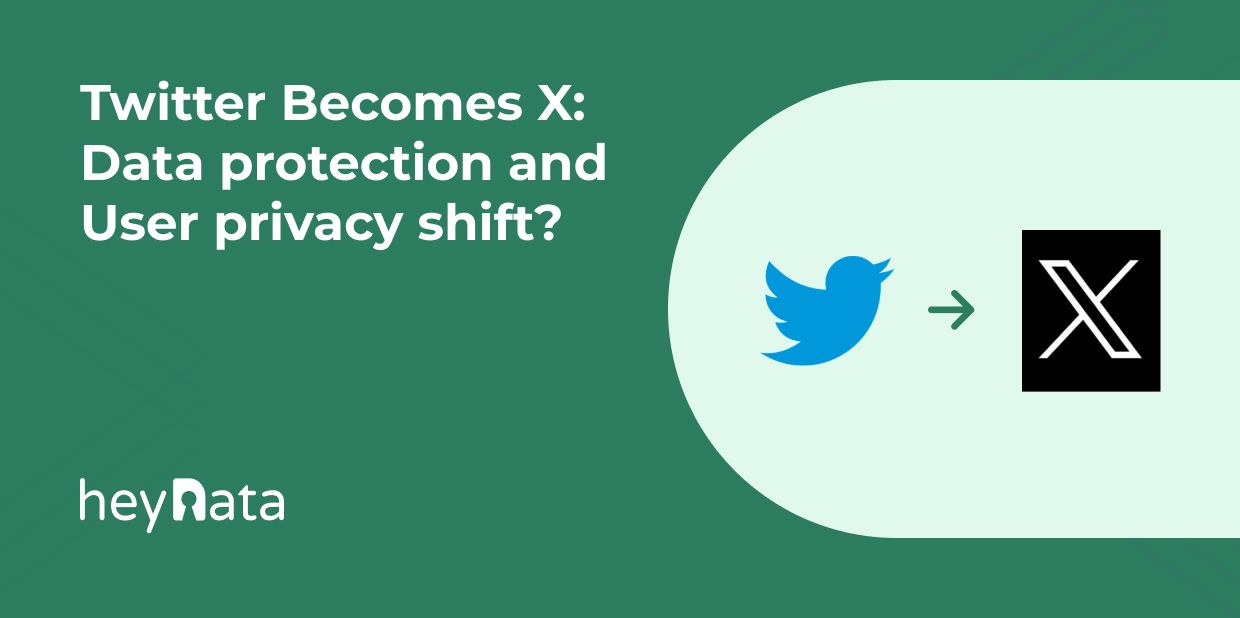
Twitter Becomes X: Data protection and User privacy shift?

In a surprising move, Elon Musk, who acquired the beloved social network Twitter in October 2022, has now revealed the company's rebranding as X, ushering in an exciting new era of interactivity and innovation. The transition involved replacing the iconic blue bird logo with a sleek and modern X emblem, signifying the company's ambitions to transform into an “everything app“ with boundless possibilities.
So how does Twitter's rebranding to X signal significant shifts in the company's approach to data protection and user privacy?

Source: https://twitter.com/elonmusk/status/1683378289031761920
Unraveling X's Vision: The 'Everything App'
Elon Musk, “the brain” behind the X concept, has been nurturing this idea since the late 1990s when he first envisioned x.com as an online bank. His previous ventures, from x.com (later becoming PayPal) to SpaceX and Tesla's Model X, all testify to his forward-thinking mindset. The rebranding decision is an integral part of Twitter's larger vision to become an 'everything app.' According to a tweet by Twitter CEO Linda Yaccarino, X aims to become a platform “centered in audio, video, messaging, payments/banking—creating a global marketplace for ideas, goods, services, and opportunities. Powered by AI.” However, concerns arise about the feasibility and privacy implications of such a super app, given Western markets' increasing awareness of data privacy issues.

Source: https://twitter.com/lindayacc/status/1683213895463215104
What does the X platform promise?
The ambitious X aims to incorporate a credibility score to combat the spread of misinformation and bots, fostering an environment of trust and reliability. Nevertheless, according to Wired, experts still question the feasibility of X's super app status, as it requires a robust financial technology infrastructure, unwavering compliance with regulations, and the rebuilding of user and advertiser trust that waned during Musk's tenure.
X’s Data Protection and User Privacy:
Many tech companies have often ventured into fintech to maximize their revenue streams and expand their product and service portfolios. Ride-hail companies like Uber, Grab, and Go-Jek, as well as tech giants Meta (Facebook) and Apple, have all delved into finance products to pay drivers and facilitate payments from users. Meta's recent attempt includes rolling out payments through WhatsApp in Brazil, while Apple has been expanding its payment ecosystem with Apple Pay, Apple Card, and Apple Savings. According to Devin Kohli, cohead at venture capital firm Outward VC, “people care about social, but if you control their money flow, your engagement is going to be very high and churn very low.”
As X endeavours to create an all-encompassing digital ecosystem, concerns about data protection and user privacy come to the forefront. As X Corp. begins to reshape Twitter's landscape, the absence of the Trust & Safety team raises concerns about the platform's ability to address issues like hate speech, misinformation, and user safety. Besides, Fintech experts expressed scepticism regarding Twitter's ability to establish a financial infrastructure that users would trust and that regulators would approve due to the regulatory challenges the company has faced under Musk’s leadership including, 1. legal notices in June from the Australian government demanding explanations about its policies on hate speech. 2. adhering to the European Union's strict Digital Services Act if it can’t comply with strict rules on managing disinformation. 3. the leak of Twitter's own internal documents in December, termed the “Twitter Files“, further exacerbated the trust issues the platform faces.
The Uncertain Road Ahead
While Twitter's operations will remain unaffected in the short term, vigilance is essential regarding X's new policies and practices concerning data handling. As data may find its way to unexpected destinations, users and privacy advocates must stay vigilant in safeguarding their digital information.
X vs Threads
Industry experts warn that the rebranding of 15-year-old app could pose high risks, especially when competitors are intensifying their presence. Following the release of Threads launched by Mark Zuckerberg’s Meta, Twitter has faced a significant drop in traffic and suffered financially from advertisers withholding spending.
According to Mike Proulx, research director at the analysis firm Forrester, “by changing Twitter’s app name, Elon Musk will have singlehandedly wiped out over 15 years of a brand name that has secured its place in our cultural lexicon“ (The Guardian).
Learn more: Threads vs. Twitter - A battle for User Attention
Conclusion: Balancing Innovation, AI-powered Features and Data Protection
The introduction of cutting-edge AI technology through xAI into the X super app is a game-changer. However, amidst the excitement surrounding AI-powered features, data protection remains paramount.
The success of X as an 'everything app' hinges on earning back the trust of users and advertisers who may have turned away from Twitter due to past controversies. Therefore, to ensure a successful journey towards the ‘everything’ app while upholding user trust, it is crucial for X to implement robust data protection measures, including encryption, secure user authentication, and stringent access controls, to ensure the utmost privacy and security of user data.
To ensure the success of X Corp as it embarks on its journey to become an all-encompassing digital ecosystem, the key lies in striking a delicate balance between innovation and user privacy. Building a trustworthy financial technology infrastructure and adhering to data protection regulations will be essential in gaining users' trust and confidence.
As users and stakeholders in the digital era, it is crucial to monitor X Corp.'s actions closely and advocate for transparent data handling practices. By holding X Corp. accountable and emphasizing the importance of data protection, we can contribute to shaping a digital landscape that embraces innovation without compromising user privacy and security.
Don’t forget to subscribe to our email newsletter to get more data protection and compliance updates and latest blogs delivered right to your inbox.


